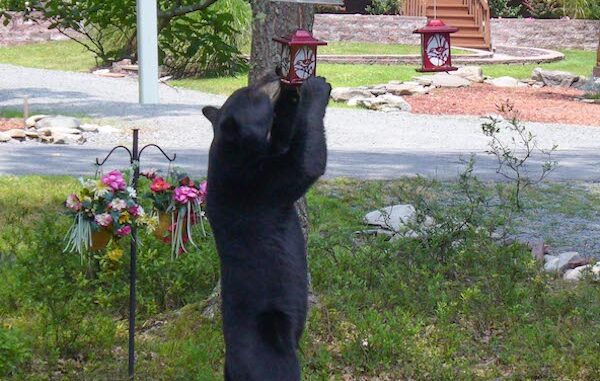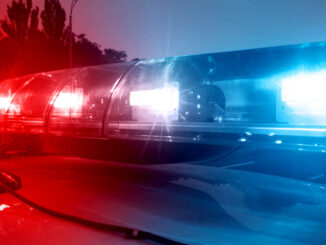
It’s bear season in North Carolina – the time to see them, not hunt them.
Several reports of bear sightings in Columbus and surrounding areas have been shared in recent days on social media. One bear was struck and killed at White Lake last week. North Carolina experiences an increase in people reporting that they’ve seen a bear, in both rural and urban areas.
Calls to the N.C. Wildlife Resources Commission’s (NCWRC) Wildlife Helpline increase with daily questions about bears, peaking from late April through August. There are several reasons for that.
“Bears are emerging from their winter dens during spring and becoming more active,” said Colleen Olfenbuttel, NCWRC’s game mammals and surveys supervisor and bear expert. “Mother bears have emerged from their den with their cubs, one-year-old bears are leaving their family group and roaming to find a new home, and, with breeding season just around the corner, male bears are starting to travel extensively searching for mates. Also, bears are hungry after hibernation, so they are all roaming around looking for food.”
Natural food resources are more limited during springtime than in summer and fall. Early spring foods include broadleaf plants and insects, but bears will actively seek out and use any abundant food source they can find, including unsecured trash cans and bird feeders in residential areas.
As the state’s bear population has grown over the past 50 years, the residential footprint has also expanded. People and bears are sharing more of the same lands which creates increased opportunities for bears to approach peoples’ homes and property, especially when food sources are left readily available to bears.
Ongoing research suggests that areas where bears are being fed, either intentionally or unintentionally, experience both a higher number of vehicle strikes and loss of their natural wariness of humans. Bears can become bold when they are purposely fed or grow accustomed to feeding on outdoor pet food, table scraps, garbage and birdseed. This can lead to bears damaging property, entering occupied homes, and causing direct threats to human safety.
“It’s imperative for the public to never feed a bear whether intentionally or inadvertently, as it will cause it to become habituated to people and alter its natural behavior,” added Olfenbuttel.
Proactive prevention of bear issues is key. At the first indication that bears are active, neighbors who work together to quickly remove outdoor foods or other attractants will encourage bears to move on and not return.
Simply seeing a bear crossing a road or in a wooded area near homes is not a cause for alarm, experts said.
Ashley Hobbs is NCWRC’s BearWise coordinator. She says while black bears are not inherently dangerous and are rarely aggressive toward people, she encourages the public to do their part to reduce the potential for conflicts and recommends implementing the BearWise® Basics, which can be found at ncwildlife.org.
“BearWise offers proven techniques to prevent conflicts with black bears, in addition to providing solutions to address the conflicts you may already be experiencing,” said Hobbs.
The recommendations from bear experts include:
- Never feed or approach bears.
- Secure food, garbage and recycling.
- Remove bird feeders when bears are active.
- Never leave pet food outdoors.
- Clean and store grills and smokers.
- Alert neighbors to bear activity.
Calls to NCWRC’s Wildlife Helpline about possible orphaned cubs also increase this time of year. NCWRC advises that a bear cub seen alone is rarely orphaned or abandoned.
A recent incident in western North Carolina involving people posing with selfies with bear cubs gained national headlines. One of the bears escaped. The other had to be turned over to the state’s licensed bear rehabilitation facility.
“People who try to capture or handle a cub are not only risking the cub’s safety, but their own if the mother bear is nearby, as she may try to defend her cubs,” Olfenbuttel said. “Even if you don’t see the mother bear, she could be nearby, and the cubs are waiting for her to return. By trying to capture a bear cub, you may cause it to become orphaned, injured or both.”
NCWRC advises to give the mother plenty of room and time to reconnect with her cub. To avoid harming yourself or the bear cub:
- Do not handle it.
- Do not attempt to catch it.
- Do not remove it.
- Do not feed it.
- Do take note of your location and call the NC Wildlife Helpline (866-318-2401). If after business hours or on weekends, call a district wildlife biologist to report it.
NCWRC does not relocate bears. The process of relocating bears can be dangerous to personnel and the bear, and generally is not an effective solution. There are no remote areas remaining in the state in which to relocate bears where they are unlikely to interact with humans, and relocation would move the problem to a new location.
Additionally, relocated bears commonly attempt to return to where they were originally captured, placing them at higher risk of mortality. If the original source of food attractant is not removed, other bears will also be drawn to the neighborhood. In most situations, leaving the bear alone and removing a food source will resolve conflicts.
And always remember this BearWise Basic: never approach or try to take closeup photos with black bears.
“It often does not end well for people or the bear,” said Olfenbuttel.
For more information on black bears visit NCWRC’s species webpage and BearWise.























